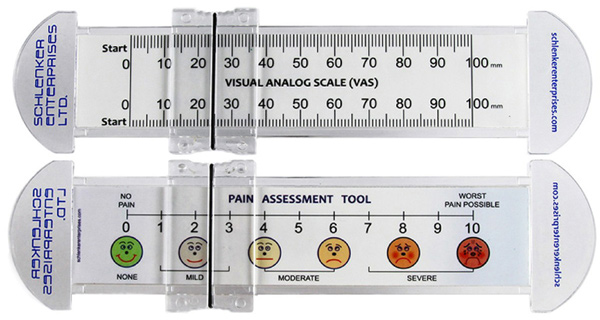Visual Analog Scale (VAS for Pain is a communication tool that can be used by a medical practitioner to understand the intensity of pain felt by her patient with chronic pain. We have already discussed the importance and usability of different types of pain scales in one of our earlier articles. Here, we will be focusing solely on the Visual Analog Scale for Pain, commonly known as the VAS pain scale.
What is a Visual Analog Scale (VAS) for Pain?
Technically speaking, Visual Analog for Pain consists of a horizontal (or vertical) line, usually 100mm in length. The left end of the line signifies no pain which is depicted by a smiling face while the right end signifies the worst possible pain with a frowning face. This visual depiction of pain levels helps the patient to communicate about the intensity of their pain.

Significance of Visual Analog Scale (VAS) for Pain
As the intensity of pain in VAS is majorly depicted with images of facial expression, it can be used on a wide range of patients including little children and elderly people who might not be accustomed to using other pain scales such as the Numerical Rating Pain Scale. It is much easier for any patient to express their perception of the intensity of their pain on VAS rather than converting it to a number as required in the Numerical Pain Scale. The patient can simply mark a spot on the scale that they feel represents their current state of pain.
The VAS is also more convenient when it comes to monitoring the pain progression in patients with chronic pain. The patient can easily indicate the level of increased or decreased pain on the scale which can be compared with the earlier level of pain. VAS is not only simple and time-saving but is also considered to be reasonably accurate.
Scoring and Interpretation of the Pain on VAS
Once the patient has marked the spot to signify her perception of the pain, it is time for the medical practitioner to score and interpret the intensity of pain. She needs to measure the distance between 0 and the point marked by the patient. The distance is measured in millimeters and interpreted as follows:
- 0 to 4 mm – No Pain
- 5 to 44 mm – Mild Pain
- 45 to 74 mm – Moderate Pain
- 75 to 100 mm – Severe Pain
Merits of VAS Pain Scale
- Even a slight change in the intensity of pain can be recorded easily.
- It is very useful in creating a comparison chart if the patient experiences fluctuations in the intensity of pain.
- It requires very little time; generally less than a minute.
- No special training is required to interpret the result. The person only needs to know how to measure using a ruler.
- There’s minimal translation difficulty. Hence, can be used universally.
Reliability and Limitations of VAS Pain Scale
- Perception of pain is a highly subjective matter. The result noted is completely based on the patient’s perception of their pain.
- Cannot be used reliably for comparing different patients at one point in time.
- It is a paper-pencil method and cannot be used by a doctor over the phone or when the doctor and the patient are geographically apart.
Use the citation below to add this article to your bibliography
"Visual Analog Scale for Pain (VAS): Scoring Pain on 100mm Line." Wecapable.com. Web. June 15, 2025. <https://wecapable.com/vas-pain-scale-100mm-line/>
Wecapable.com, "Visual Analog Scale for Pain (VAS): Scoring Pain on 100mm Line." Accessed June 15, 2025. https://wecapable.com/vas-pain-scale-100mm-line/
"Visual Analog Scale for Pain (VAS): Scoring Pain on 100mm Line." (n.d.). Wecapable.com. Retrieved June 15, 2025 from https://wecapable.com/vas-pain-scale-100mm-line/

Where can I buy this Visual Analog Scale (VAS) for Pain